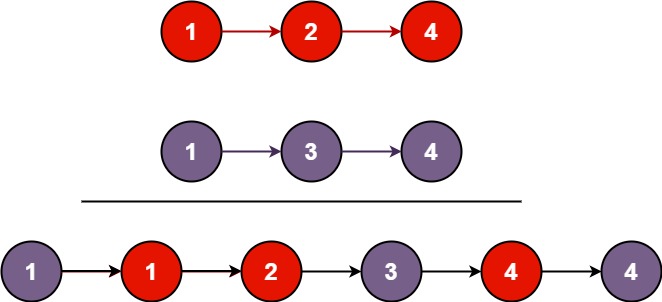LeetCode第21題_Merge Two Sorted Lists (Easy)
You are given the heads of two sorted linked lists list1 and list2.
Merge the two lists in a one sorted list. The list should be made by splicing together the nodes of the first two lists.
Return the head of the merged linked list.
Example 1:

Input: list1 = [1,2,4], list2 = [1,3,4] Output: [1,1,2,3,4,4]
Example 2:
Input: list1 = [], list2 = [] Output: []
Example 3:
Input: list1 = [], list2 = [0] Output: [0]
Constraints:
- The number of nodes in both lists is in the range
[0, 50]. -100 <= Node.val <= 100- Both
list1andlist2are sorted in non-decreasing order.
題目給我們兩個已經排列過的LinkedList
那需要我們把此兩個LinkedList給合在並回傳也排序後的List
[1,3,5,7]
[2,4,6,8]
->[1,2,3,4,5,6,7,8]
2.直接使用兩個循環進行比較:這種方法通常會忽略兩個列表已經有序的特點,導致不必要的比較操作和額外的時間複雜度。
node 2的指標再從指向4改接續指向3
就無任何人指向node 3了。(再也取不到node 3了也無法繼續排序下去)
不能只透過改pointer來做順序調整
你需要有兩個手法
一開始會有兩個list pointer分別list1,list2
分別指向最小的起始node 後續每次跌代比對會順移至下一個最小的
再來還需要一個dummy head 這個node(當中的值不重要)
我們會需要以它來作為開頭,建立排序後的list。
當兩個連結串列分別是 1 -> 3 -> 5 -> 7 和 2 -> 4 -> 6 -> 8 時
list1: 1 -> 3 -> 5 -> 7
list2: 2 -> 4 -> 6 -> 8
創建一個假節點(dummy node)作為新連結串列的起始節點
dummy -> NULL
初始化遍歷指針 curr 指向假節點(dummy node):
dummy -> NULL
curr
開始進行迴圈遍歷,比較兩個連結串列的節點值,並將較小的節點連接到新連結串列上。
同時,將對應的遍歷指針向後移動:
list1: 3 -> 5 -> 7
list2: 2 -> 4 -> 6 -> 8
dummy -> 1 -> NULL
curr
繼續遍歷,比較兩個連結串列的節點值,並將較小的節點連接到新連結串列上
list1: 3 -> 5 -> 7
list2: 4 -> 6 -> 8
dummy -> 1 -> 2 -> NULL
curr
繼續遍歷,比較兩個連結串列的節點值,並將較小的節點連接到新連結串列上
list1: 5 -> 7
list2: 4 -> 6 -> 8
dummy -> 1 -> 2 -> 3 -> NULL
curr
繼續遍歷,比較兩個連結串列的節點值,並將較小的節點連接到新連結串列上
list1: 5 -> 7
list2: 6 -> 8
dummy -> 1 -> 2 -> 3 -> 4 -> NULL
curr
繼續遍歷,比較兩個連結串列的節點值,並將較小的節點連接到新連結串列上
list1: 7
list2: 6 -> 8
dummy -> 1 -> 2 -> 3 -> 4 -> 5 -> NULL
curr
繼續遍歷,比較兩個連結串列的節點值,並將較小的節點連接到新連結串列上
list1: 7
list2: 8
dummy -> 1 -> 2 -> 3 -> 4 -> 5 -> 6 -> NULL
curr
繼續遍歷,比較兩個連結串列的節點值,並將較小的節點連接到新連結串列上
list1: NULL
list2: 8
dummy -> 1 -> 2 -> 3 -> 4 -> 5 -> 6 -> 7 -> NULL
curr
繼續遍歷,比較兩個連結串列的節點值,並將較小的節點連接到新連結串列上
list1: NULL
list2: NULL
dummy -> 1 -> 2 -> 3 -> 4 -> 5 -> 6 -> 7 -> 8 -> NULL
curr
最終得到了合併後的連結串列 1 -> 2 -> 3 -> 4 -> 5 -> 6 -> 7 -> 8
因此最不理想情況下就是
兩個List各自長度分別M跟N,時間複雜度就是 O(M+N)
但不一定都會試M+N次 ,因為其中有一個List比較短就直接中斷即可直接原封不動把
剩餘較長的list補上。(題目有說兩個list都是排序過的)
優點:使用迴圈和條件判斷來遍歷兩個有序列表並合併它們。
缺點:這個作法需要使用額外的記憶體空間來建立合併後的新列表,並需要遍歷和排序整個列表,時間複雜度較高。
class Solution {
public:
ListNode* mergeTwoLists(ListNode* list1, ListNode* list2) {
ListNode* dummy = new ListNode(0);
ListNode* curr = dummy;
while (list1 && list2) {
if (list1->val <= list2->val) {
curr->next = list1;
list1 = list1->next;
} else {
curr->next = list2;
list2 = list2->next;
}
curr = curr->next;
}
curr->next = list1 ? list1 : list2;
ListNode* result = dummy->next;
delete dummy;
return result;
}
};
ListNode* dummy = new ListNode(0);
創建一個新的 ListNode 物件,並將其指標分配給 dummy。這個節點被稱為假節點(dummy node),值為0。假節點是用於簡化合併列表的過程,它的下一個指向最終合併後的列表。
ListNode* curr = dummy;創建一個指標 curr,並將其初始化為dummy。這個指標curr用於遍歷合併後的列表,最初指向假節點(dummy node)。
while (list1 && list2) {....}進入一個 while 迴圈,只要 list1 和 list2 都還有節點,就繼續執行迴圈內的程式。
if (list1->val <= list2->val) { curr->next = list1; list1 = list1->next;} else { curr->next = list2; list2 = list2->next;}判斷 list1 和 list2 目前節點的值,如果 list1 的值小於等於 list2 的值,則將 curr 的下一個指向 list1,並將 list1 的指標往後移動到下一個節點。如果 list1 的值大於 list2 的值,則將 curr 的下一個指向 list2,並將 list2 的指標往後移動到下一個節點。
curr = curr->next;將 curr 的指標往後移動到下一個節點,準備處理下一個節點的合併。
curr->next = list1 ? list1 : list2;退出 while 迴圈後,將剩餘的 list1 或 list2 接到 curr 的下一個節點,這是因為其中一個列表可能還有未處理的節點。
ListNode* result = dummy->next;將合併後的列表的起始節點指標設為 result,即假節點(dummy node)的下一個節點。
delete dummy;釋放假節點(dummy node)的記憶體,避免內存洩漏。return result;回傳合併後的列表的起始節點指標,即 result。
進階作法:
優點:這個作法遞迴地合併兩個有序列表,使用分治演算法的概念。不需要額外的記憶體空間,只需在原地修改列表的指標。
缺點:這個作法可能在處理非常長的列表時遇到深度遞迴限制,可能導致堆疊溢出的問題。
class Solution {
public:
ListNode* mergeTwoLists(ListNode* list1, ListNode* list2) {
if (!list1) return list2;
if (!list2) return list1;
if (list1->val <= list2->val) {
list1->next = mergeTwoLists(list1->next, list2);
return list1;
} else {
list2->next = mergeTwoLists(list1, list2->next);
return list2;
}
}
};
if (!list1) return list2;
if (!list2) return list1;
檢查 list1 和 list2 是否為空。如果其中一個列表為空,則直接返回另一個列表,因為空列表不需要進行合併操作。
if (list1->val <= list2->val) {
list1->next = mergeTwoLists(list1->next, list2);
return list1;
} else {
list2->next = mergeTwoLists(list1, list2->next);
return list2;
}
在這段程式中,比較 list1 和 list2 目前節點的值。
如果 list1 的值小於等於 list2 的值,則將 list1 的下一個節點指向遞迴調用 mergeTwoLists 函式的結果,並返回 list1 作為合併後的列表的起始節點。
否則,將 list2 的下一個節點指向遞迴調用 mergeTwoLists 函式的結果,並返回 list2 作為合併後的列表的起始節點。
這種作法使用了遞迴,通過比較兩個列表的值並將節點串聯起來,達到合併列表的目的。
遞迴的終止條件是其中一個列表為空,此時直接返回非空列表即可。
遞迴的過程中,不斷比較兩個列表的值並遞歸調用 mergeTwoLists 函式,直到其中一個列表遍歷完畢。








留言
張貼留言